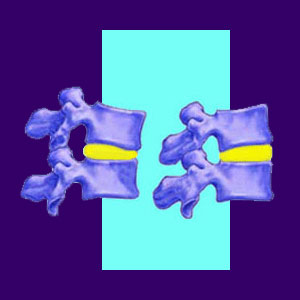
Facet joint syndrome, otherwise known as facet joint disease, facet degeneration, facet hypertrophy or facet syndrome, is an osteoarthritic condition that affects the zygapophysial joints in the spine. The facet joints are the areas where the vertebrae actually join together. They are designed to impart strength, flexibility and spinal integrity, as well as offer a range of defined movement for each vertebral level. Being that these joints are involved in vertebral movement, it is normal that they will experience wear and tear from the arthritic processes and will likely show marked effects of this aging within 3 to 4 decades of life.
Facet joint diagnoses have become a hot item in the back pain treatment sector. The degeneration is there for all to see and can easily be targeted, sometimes fairly and sometimes not, as the source of symptoms in a diversity of pain syndromes. My biggest complaint with the way facet joint pain is handled is that diagnosis usually comes by way of exclusion and anesthetic injection. Both of these techniques are extremely imprecise, leading to a higher than average chance for misdiagnosis of the condition as the true causation of suffering.
This resource section provides a thorough overview of facet joint syndrome.
Facet Joint Syndrome Anatomy
The spinal facet joints link the vertebrae to one another and provide the flexibility for individual movement of each bone. Cartilage covers the surface of the bones in the facet joints. Each joint is covered by a capsule of ligaments and soft tissue. This capsule contains synovial fluid that is used to lubricate the joint and keep it moving smoothly and without friction.
This combination of cartilage, ligament and synovial fluid keeps a young and healthy joint moving effortlessly, without any bone on bone contact. There is also a fair amount of nerve tissue that runs into each one of these lubricating capsules.
Degeneration of the facet joints is normal and will usually be noticeable by the ages of 30 to 40 in some areas of the spine. So in essence, the terminology facet joint syndrome describes a process that we know will occur, but just to what extent in a given individual remains the variable part of the equation.
Facet Syndrome Topics
Facet syndrome is a multidimensional topic. We have prepared an encyclopedia of niche articles to help patients understand every aspect of the condition:
Finding relief from facet syndrome relies on accurate diagnosis and successful treatment.
Facet joint arthritis, also known as facet arthropathy or facet joint arthrosis, is the most common source of facet joint pain.
Facet joint degeneration is normal to experience in many areas of the spine and is not inherently painful.
Facet syndrome symptoms might include local or regional pain, especially when the area is mobilized.
Facet joint pain is usually not debilitating, but can be one of the more common types of spinal joint pain syndromes.
Facet joint back pain is usually expressed in cases of pathological degeneration in the thoracic and lumbar levels of the vertebral column. Meanwhile, facet joint neck pain can result from degeneration in the cervical spine. Learn more about lumbar facet syndrome.
Facet syndrome causes include aging, injury and other case-specific factors.
Osteophytes are commonly associated with facet arthrosis conditions.
Facet syndrome is one of the more debated diagnostic theories, since the symptoms often do not correlate to clinical expectations.
Facet syndrome treatment usually focuses on conservative or minimally invasive methods of care. Nonsurgical facet joint therapy options span the gamut of back and neck pain treatment modalities. Facet joint surgery is typically held in reserve for serious symptoms that do not respond to more conservative care practices.
Facet hypertrophy describes inflammation of certain parts of the facet joints.
Facet syndrome exercises are a typical therapy recommendation, despite the lack of logic in the prescription.
Do you have spinal joint pain? Facet-Joint-Pain.Com provides an insightful and objective view of facet joint pain problems, including facet syndrome, facet hypertrophy and facet joint degeneration.
Facet Joint Syndrome Diagnosis
There is considerable medical controversy about whether this is an actual condition unto itself or just the byproduct of osteoarthritis. The spinal facet joints are in constant motion and do suffer degeneration as part of their normal lifespan. The whole human body degenerates as we age, so this is no surprise. Degeneration of the facet joints is simply a normal part of life, experienced universally as we get older. Being diagnosed as having facet degeneration should be no shock to anyone past age 40.
Degeneration of these joints occurs when the cartilage wears thin and the synovial fluid leaks out or dries up. This causes increased friction in between the individual vertebra. Is this harmful? Is this painful? Well, it depends on who you ask.
Pain might come from the actual bone on bone contact. This makes sense. The protective measures inside the joint are designed to prevent bone to bone contact. When contact occurs, there might be some discomfort. Is this pain abnormal? No. Some minor arthritis pain is completely normal.
However, many people have worn facet joints and suffer no pain or symptoms at all. Meanwhile, other patients have very low levels of facet arthritis, but experience widespread regional back pain which is illogically traced back to the obviously coincidental facet issues. This is a huge problem.
Pain might also occur if a bone spur creates a pinched nerve. This occurs mainly due to serious spinal osteoarthritis and the build up of osteophytes around the foraminal openings. The facet joints are one of the main true sources of mechanical back pain symptoms. In these cases, the diagnosis is correct in many patients, as long as the symptoms are logical for the suspected cause, including pain over a particular and defined range of motion at a particular vertebral level.
Facet Joint Syndrome Guidance
Facet joint syndrome is a normal part of aging. If you think of it this way, you are unlikely to suffer serious symptoms. Some aches and pains are normal as we get older. They are unavoidable. However, serious facet joint pain is rare.
Facet syndrome is also one of many structural conditions that have become popular scapegoats for treatment-resistant back pain. If this is your situation, learning more about knowledge therapy might be the approach to care you really need. No risks and no costs. Compare that to the multitude of drugs and injection therapies used unnecessarily each year to treat completely innocent and coincidental facet degeneration.
We are proud to offer a proven and peer-acclaimed pain relief program that works particularly well for facet joint syndrome symptoms. The program is available online for 24/7 access from anywhere in the world.





